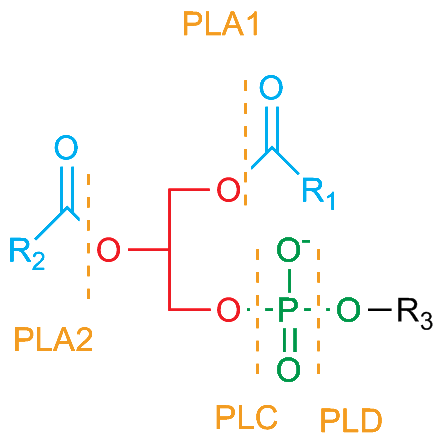|
Phospholipase B
Phospholipase B, also known as lysophospholipase, is an enzyme with a combination of both PLA1 and PLA2 activities; that is, it can cleave acyl chains from both the sn-1 and sn-2 positions of a phospholipid. In general, it acts on lysolecithin (which is formed by the action of PLA2 on lecithin). See also * Phospholipase A phospholipase is an enzyme that hydrolyzes phospholipids into fatty acids and other lipophilic substances. Acids trigger the release of bound calcium from cellular stores and the consequent increase in free cytosolic Ca2+, an essential step in ... References * {{Esterases ... [...More Info...] [...Related Items...] OR: [Wikipedia] [Google] [Baidu] |
Lysolecithin
Lysophosphatidylcholines (LPC, lysoPC), also called lysolecithins, are a class of chemical compounds which are derived from phosphatidylcholines. Overview Lysophosphatidylcholines are produced within cells mainly by the enzyme phospholipase A2, which removes one of the fatty acid groups from phosphatidylcholine to produce LPC. Among other properties, they activate endothelial cells during early atherosclerosis. LPC also acts as a find-me signal, released by apoptotic cells to recruit phagocytes, which then phagocytose the apoptotic cells Moreover, LPCs can be used in the lab to cause demyelination of brain slices, to mimic the effects of demyelinating diseases such as multiple sclerosis. Further, they are known to stimulate phagocytosis of the myelin sheath and can change the surface properties of erythrocytes. LPC-induced demyelination is thought to occur through the actions of recruited macrophages and microglia which phagocytose nearby myelin. Invading T cells are also th ... [...More Info...] [...Related Items...] OR: [Wikipedia] [Google] [Baidu] |
Lecithin
Lecithin (, from the Greek ''lekithos'' "yolk") is a generic term to designate any group of yellow-brownish fatty substances occurring in animal and plant tissues which are amphiphilic – they attract both water and fatty substances (and so are both hydrophilic and lipophilic), and are used for smoothing food textures, emulsifying, homogenizing liquid mixtures, and repelling sticking materials. Lecithins are mixtures of glycerophospholipids including phosphatidylcholine, phosphatidylethanolamine, phosphatidylinositol, phosphatidylserine, and phosphatidic acid. Lecithin was first isolated in 1845 by the French chemist and pharmacist Théodore Gobley. In 1850, he named the phosphatidylcholine ''lécithine''. Gobley originally isolated lecithin from egg yolk – λέκιθος ''(lekithos)'' is "egg yolk" in Ancient Greek – and established the complete chemical formula of phosphatidylcholine in 1874; in between, he demonstrated the presence of lecithin in a variety of biologi ... [...More Info...] [...Related Items...] OR: [Wikipedia] [Google] [Baidu] |
Phospholipases2
A phospholipase is an enzyme that hydrolyzes phospholipids into fatty acids and other lipophilic substances. Acids trigger the release of bound calcium from cellular stores and the consequent increase in free cytosolic Ca2+, an essential step in calcium signaling to regulate intracellular processes. There are four major classes, termed A, B, C, and D, which are distinguished by the type of reaction which they catalyze: *Phospholipase A **Phospholipase A1 – cleaves the ''sn''-1 acyl chain (where ''sn'' refers to stereospecific numbering). **Phospholipase A2 – cleaves the ''sn''-2 acyl chain, releasing arachidonic acid. * Phospholipase B – cleaves both ''sn''-1 and ''sn''-2 acyl chains; this enzyme is also known as a lysophospholipase. *Phospholipase C – cleaves before the phosphate, releasing diacylglycerol and a phosphate-containing head group. PLCs play a central role in signal transduction, releasing the second messenger inositol triphosphate. * Phospholipase D – ... [...More Info...] [...Related Items...] OR: [Wikipedia] [Google] [Baidu] |

